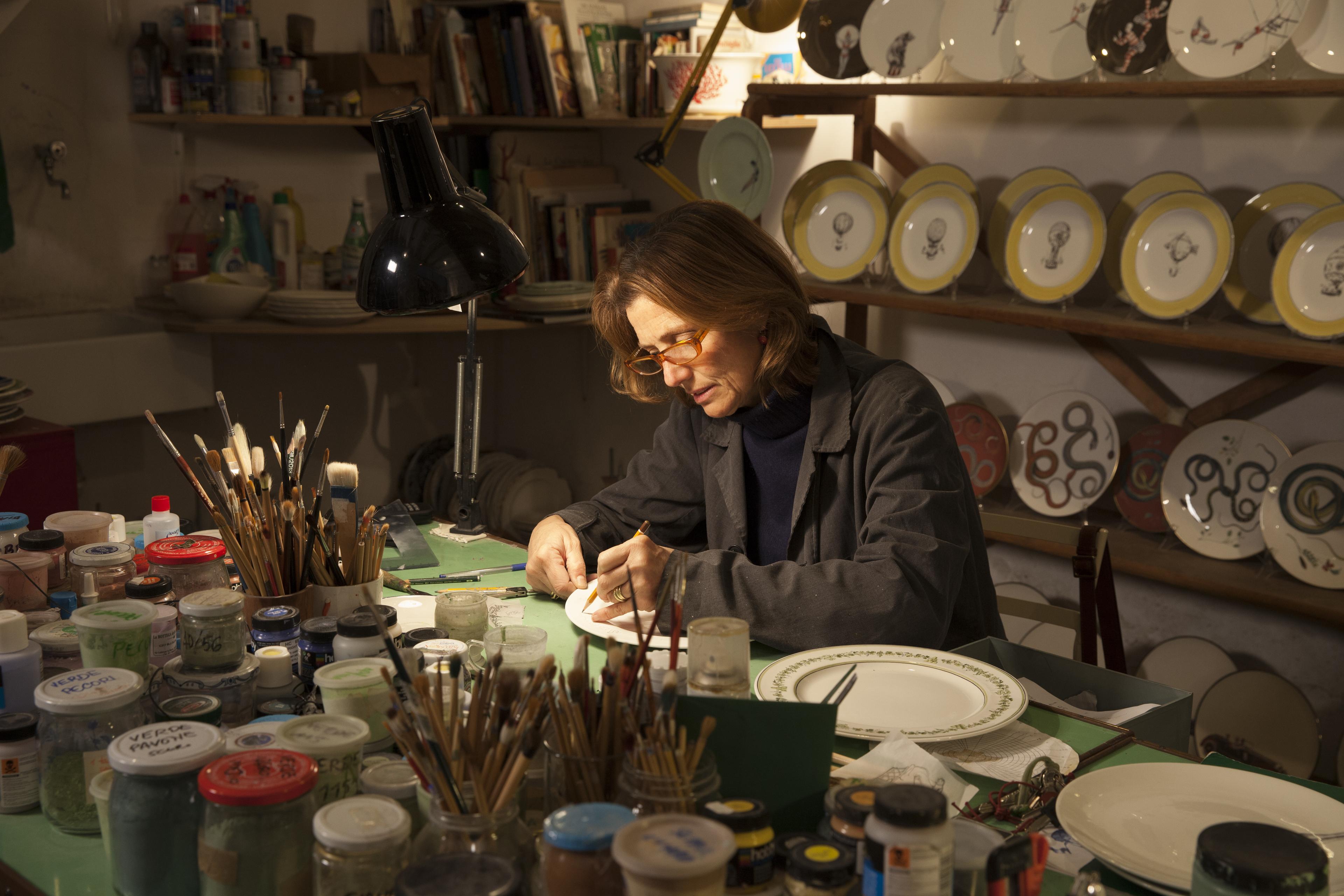
Fotoalbum Leder Blau
175 EUR
Versandt in 3-4 Wochen

Interview mit Maria Giannini, der sechsten Generation von Handwerkern der berühmten Florentiner Buchbinderfamilie.
Der Inhalt dieser Seite wurde automatisch übersetzt. Besuchen Sie die Website auf Englisch
von Valia Barriello
Was passiert, wenn sich die Geschichte einer Familie mit der Entwicklung eines künstlerischen und antiken Handwerks verflechtet? Dies ist die Geschichte der Giannini aus Florenz, Buchbinder seit 1856, die die Geheimnisse der Buchbinderei von Generation zu Generation weitergegeben haben. Die Familie Giannini hat den neuen florentinischen Stil der künstlerischen Buchbinderei und der marmorierten Papiere durch einen Prozess der ständigen Innovation geschaffen.
Ihre Arbeit hat dazu beigetragen, einen einzigartigen Stil zu definieren, der bis ins neunzehnte Jahrhundert zurückreicht. Was ist Ihr künstlerischer Beitrag und welche Innovationen wurden eingeführt?
Uns wird vor allem die Schaffung des "Florentiner Stils" zugeschrieben, der nicht nur auf Einbänden, sondern auch auf verschiedenen Gegenständen reproduziert wurde. Dies war die eigentliche Innovation - der Druck von dekorativen Elementen auf Packpapier, das auch zum Auskleiden von Gegenständen verwendet wurde. Bis 1940 wurde dieses Verfahren hauptsächlich mit Leder oder Pergament durchgeführt.
Das ist ein Handwerk, das von Generation zu Generation weitergegeben wird. Aber wie kann man mit der Zeit gehen?
Jede Generation musste sich mit unterschiedlichen historischen Epochen auseinandersetzen, die sich auf die Herstellung und Ausführung von Einbänden und Objekten auswirkten. Jahrhundert waren die Hauptkunden die englische und russische Aristokratie. Nach dem Zweiten Weltkrieg kamen die Amerikaner. Hochwertige Materialien wie Leder und Pergament waren sehr teuer geworden, so dass es notwendig wurde, die Produktion von handdekoriertem Papier (Marmorpapier) zu erhöhen.Nach den 70er Jahren gab es einen Boom. Mit der Zeit Schritt zu halten bedeutet, originell zu sein und schnell den Kurs zu ändern, aber diese beiden Elemente sind nicht gleichbedeutend mit traditioneller Handwerkskunst.Die Tatsache, eine kleine Produktion zu haben, erleichtert die Erneuerung.
Haben Sie jemals befürchtet, dass Ihr Unternehmen verschwinden könnte?
Ja, das passiert mehr oder weniger bei jedem Generationswechsel! Dies ist gut dokumentiert in dem Tagebuch meines Urgroßvaters Guido mit dem Titel "Uscio e Bottega. Ricordi di un artigiano fiorentino" (Uscio und der Laden. Erinnerungen eines Florentiner Handwerkers). Ein Buch, das wir anlässlich unseres 150-jährigen Jubiläums veröffentlicht haben.
Gibt es noch Leute, die dieses Handwerk lernen wollen? Nehmt ihr Lehrlinge auf oder organisiert ihr Workshops?
Im Laufe der Jahre hatten wir viele Lehrlinge, aber in letzter Zeit war dies aufgrund des mangelnden Interesses, aber auch wegen unserer finanziellen Situation nicht mehr möglich. Stattdessen veranstalten wir Workshops, in denen man zuschauen und sogar selbst Marmorpapier und kleine Bücher aus Papier und Leder herstellen kann.
Wer sind Ihre Kunden?
Es sind vor allem amerikanische und britische Touristen mit einem starken kulturellen Hintergrund, aber auch Japaner und Asiaten, die hochwertige, handgefertigte Produkte suchen. Was unsere Arbeiten mit künstlerischem Einband betrifft, so sind die Käufer in der Regel italienische Sammler, aber davon gibt es heute nur noch wenige.
Trägt eine Stadt wie Florenz zum Erfolg Ihres Unternehmens bei?
MG: Wir sind ein integraler Bestandteil von Florenz. Die Stadt ist wichtig für alle Kunsthandwerker, und es ist eine gegenseitige Beziehung. Unser Geschäft ist auch ein Teil des kulturellen Erbes von Florenz. Aus diesem Grund haben wir den Fiorino d'Oro erhalten, die höchste Auszeichnung der Stadt Florenz.
Zukünftige Projekte?
Wir wollen weiterhin mit Künstlern zusammenarbeiten. So können wir uns neuen Herausforderungen stellen und unser Know-how unter Beweis stellen. So können wir wachsen und es macht uns große Freude. Und dann gibt es mehr als ein Projekt einen Traum: ein kleines Museum mit einer aktiven Werkstatt für Papier und Bücher für die Stadt Florenz zu schaffen.
Das ist etwas, das in dieser Stadt fehlt, und es wäre großartig, die Geschichte und Kultur dieses für die Tradition dieser Stadt so wichtigen Handwerks zu bewahren.
Über die Autorin Valia Barriello ist Architektin und Designprofessorin und arbeitet in Mailand. Barriello ist auch in der Produktion und in Redaktionen tätig.

175 EUR
Versandt in 3-4 Wochen

285 EUR
Versandt in 3-4 Wochen

175 EUR
Versandt in 3-4 Wochen

135 EUR
Versandt in 1 Woche

135 EUR
Versandt in 1 Woche

90 EUR
Versandt in 1 Woche

590 EUR
Versandt in 1-2 Wochen

Verwurzelt in jahrhundertealter italienischer Handwerkskunst und doch von ständigem Experimentiere…

Biancoperla entstand in den späten 1950er Jahren aus der Leidenschaft der Familie Sali für feine T…